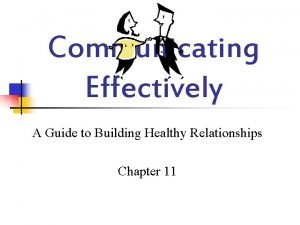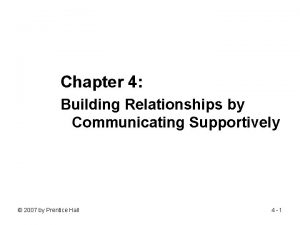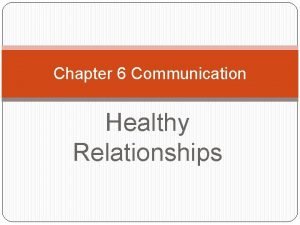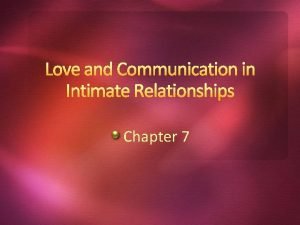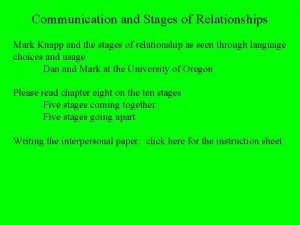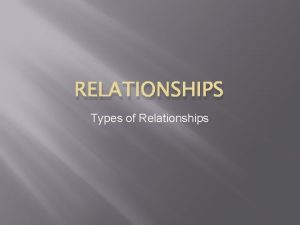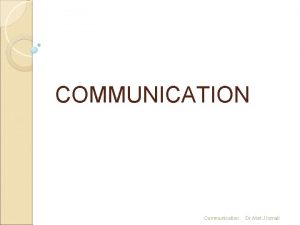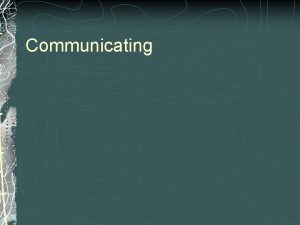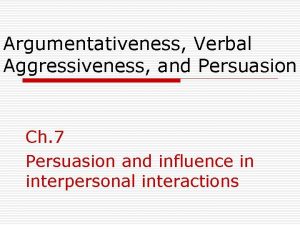COMMUNICATING IN RELATIONSHIPS Types of Communication 1 Aggressiveness












- Slides: 12

COMMUNICATING IN RELATIONSHIPS

Types of Communication 1. Aggressiveness � Taking what you want, threatening or forcing a person to give you something, or saying “no” in a way that puts the other person down or violates his or her rights. Consequences of aggressiveness: � Often gets you what you want, but the other person will definitely not appreciate it. You may lose a friend!

Types of Communication 2. Passiveness � Not speaking up when you’d like something or giving in and saying “yes” when you don’t really want to, in order to be liked or not hurt the other person’s feelings. Consequences of passiveness: � Usually don’t get you what you want, and you may lose the respect of others.

Types of Communication 3. Manipulation � Getting what you want or turning someone down in a dishonest way, or doing something for someone only so they’ll give you what you want. Consequences of manipulation: � Sometimes you get what you want, but other people will eventually figure it out and not like it. You may lose their trust.

Types of Communication 4. Assertiveness! � Asking straight for what you want or giving people an honest “no” to things you don’t want. It means not using other people and not letting yourself be used either. Consequences of assertiveness: � Often get you what you want, though not always, but you keep your self-respect and the other person usually appreciates it.

Four Steps of Asking for What You Want: �State a fact or a feeling. �Describe what you’d like. If they say “No”… �Ask for your second choice. If they still say, “No”… �Accept their response gracefully.

Asking for what you want: Alex and Cory have been dating casually for a few months. Alex wants the relationship to be exclusive, but Cory isn’t ready to commit. Alex doesn’t want to lose Cory but can’t stand the thought of Cory kissing other people. Alex (states what he would like): “Cory I know you went out with Tyler last night. How would you feel about only dating me? ” Cory: “Alex I really like you but I want to see other people too. ” Alex (Asks for his second choice): “Well, would you be willing to not kiss or make out with other people? That really bothers me. ” Cory: “I can do that Alex. I really do like you and I don’t want to hurt our relationship. ” Cory could have also said “no” to Alex’s request to not kiss other people. Alex would have to respect Cory’s decision and honesty, but would also have some decisions to make about whether or not to stay in the relationship. Either way Alex and Cory demonstrated some of our requirements for a healthy relationship: Communication, respect, and honesty.

Now it is your turn to practice: Imagine this scenario: You and your friend are talking about a guy/girl you both like. Last weekend you and this guy/girl really hit it off at a party. You want to ask him/her to a movie this weekend. Your friend doesn’t want you to ask this guy/girl out. Your friend has had a crush on the guy/girl for longer than you.

Communicating “NO” Assertively � Say something caring -That’s flattering but… -Thanks for asking, but… � Refuse -No, thanks. � -I like you but… -It’s nice of you to offer, but… -No, I’m Ok. -No, that’s alright. State your decision -I’d rather… -I’m going to… -I don’t believe in… -I’m not going to… OR suggest an alternative -Would you like to… -How about…

Steps to Handling Rejection Assertively � Ask straight for what you want. � If you get a “no”, ask for your second choice. -Would you consider… -How about… � If you get another “no”, accept it gracefully. -Ok, I understand. -Alright, I hear you. -Ok, thanks anyway.

Your Rights in a Relationship �Not to be lied to. �Not to be called names or put down. �To say what you feel. �To ask straight for what you want. �To have your personal thoughts and feelings kept confidential (not to be gossiped about). �To be listened to. �To have your feelings considered. �To have your touch and privacy rights respected.

Defend Your Rights � Say what you want -Stop that. to… � -I want you to… Get their attention -Hey! -Wait a minute � -Hold it. -Listen to me. -(Say their name). Call them on their aggression or manipulation. -That’s not true. -That’s not right � -I’m not going -That’s illegal. -That sounds like a threat. -That’s not what I said. Repeat what you expect -I mean it. -I asked you not to -I said, “Cut it out” � Leave � If they try to prevent you from leaving get help or get violent.
 Vaginal hydrocele
Vaginal hydrocele What is aggressiveness
What is aggressiveness Healthy relationships communicating effectively
Healthy relationships communicating effectively Building relationships by communicating supportively
Building relationships by communicating supportively Chapter 6 communication and relationships
Chapter 6 communication and relationships Define the relationship chapter 7
Define the relationship chapter 7 Stages of relationships communication
Stages of relationships communication Define the relationship ch 7
Define the relationship ch 7 What is artifactual communication
What is artifactual communication Communicating classes markov chain
Communicating classes markov chain Normal pressure hydrocephalus causes
Normal pressure hydrocephalus causes Communicating value
Communicating value Differentials for hydrocephalus
Differentials for hydrocephalus


